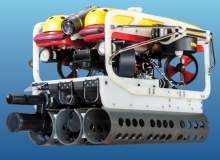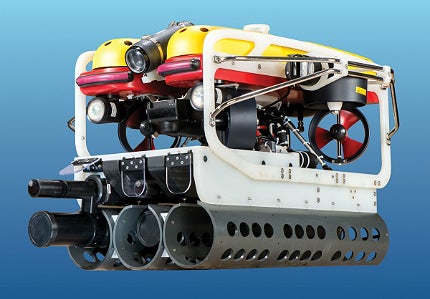

If you were to take a whistle-stop tour of the naval mines littering the ocean’s floor, it would be like peering through a window onto the last 100 years of nautical history. It is perhaps an ironic tribute to mines’ effectiveness and longevity that even the oldest still pose a threat to ocean-going vessels.
Since World War II ended, 15 US Navy ships have been sunk or seriously damaged by mines, including one that was damaged in the 1980s by an antique Russian mine dating back to 1908. Discarded wartime mines still pose a serious threat to naval operations and shipping in areas such as the Baltic archipelago, along with more recent conflicts, has brought the danger to new waters.
The UK Royal Navy has recently been clearing mines off the Libyan port of Misrata, believed to have been laid by pro-Gadaffi forces, and mines thought to have been planted by Iraq prompted a US minesweeping operation in preparation for potential amphibious landings. Iran’s recent threat to mine the Strait of Hormuz has provided a sharp new focus to naval exercises in the Gulf.
Although many of these more recent episodes of mining used old technology, which is cheap and still effective, more sophisticated mines are now being produced that are more difficult to tackle.
Some can target specific ships by looking for their magnetic, acoustic or other signature. One type uses passive sonar, which if it picks anything up turns on active sonar. If the target signature is detected, the mine will fire.
How well do you really know your competitors?
Access the most comprehensive Company Profiles on the market, powered by GlobalData. Save hours of research. Gain competitive edge.

Thank you!
Your download email will arrive shortly
Not ready to buy yet? Download a free sample
We are confident about the unique quality of our Company Profiles. However, we want you to make the most beneficial decision for your business, so we offer a free sample that you can download by submitting the below form
By GlobalDataThese factors have led to a step up in mine-hunting oriented navy drills, procurement of new mine-countermeasure vessels (MCMV) and the conversion of existing ships to the task. A variety of unmanned underwater vessels (UUVs) operate off these, tethered or free-ranging and with varying degrees of autonomy, to find, identify and destroy mines before they can do any harm. These and the charges they carry are the main weapons in keeping oceans safely navigable to naval and civilian vessels alike.
Atlas Elektonik and Saab are two companies that take very different ground-breaking approaches to clearing navigation channels of the subsurface menace of mines.
Atlas Elektronik builds the navy workhorse of choice
One system that holds a believable claim to be the naval mine countermeasure solution of choice is Altas Elektronik’s SeaFox, which has been selected by the UK Royal Navy and navies of the US, the Netherlands, Belgium, Sweden, Finland, Estonia, Thailand and UAE.
SeaFox is a one-shot semi-autonomous system guided by fibre optics and an integrated homing sonar towards a previous spotted mine. It uses an on-board camera to verify the target before deploying its built-in, large calibre shaped charge. According to Atlas, this one-way concept reduces disposal time and extends the operational envelope.
Bernd Willke, a sales manager with the company’s Naval Mine Countermeasures (MCM) Systems business, believes its international success is down to its combat-proven, simple and effective design.
"It simply works under tough environmental conditions no matter whether strong currents, high sea states or low visibility. It does its intended work regardless its host, whether helicopter, rigid-hulled inflatable boat (RHIB) or mine countermeasure vessel."
While Atlas is unable to comment on specific theatres, Willke says that ATLAS MCM systems have proved their performance and reliability, whether being operated in erratic Baltics, awkward Mediterranean or noisy tropics.
Although SeaFox has become established naval technology, Atlas is working on new ways for navies to use it. At this year’s DSEI expo in London, the company launched Atlas Remote Combined Influence Minesweeping System (ARCIMS), which launches SeaFox from a remotely operated vessel.
Dave Berry, MCM product manager with Atlas’s Surface Ship Systems division, says: "With the ATLAS towed influence mine sweeping payload, ARCIMS takes the man out of the minefield, making mine sweeping safe. ARCIMS is a versatile autonomous platform easily configured with mine hunting and disposal payloads, such as a UUV and the ATLAS SeaFox one shot mine disposal system, to search for and eliminate threat mines."
Atlas has carried out extensive acceptance trials at its sea test facility in Weymouth, Dorset, with ARCIMS in a fully autonomous unmanned mine sweeping configuration. It has already sold two systems to an export customer, which will be delivered later in the year, and has had significant interest from another potential customer.
Saab multishots make the sea safer
Saab is another naval stalwart, with its Double Eagle ROV in service with seven major navies, including Australia, France, the Netherlands and Sweden. It has developed its latest solution, Seaeye Multimine Neutralisation System (MuMNS), to use aboard reusable ROVs, to destroy several targets in a single mission, potentially saving the time and money associated with retrieving and launching one-shot systems.
Chris Lade, defence sales manager with Saab Seaeye, explains that MuMNS consists of the topside equipment for launch, control and recovery, the ROV itself along with Saab’s "Storm" mine disposal magazine, and the disposal system itself.
"The disposal system consists of four parts – the first part is in the magazine that you load the weapon into," says Lade. "The second part is the mechanism to attach the charge to the target; we use a nail gun. The third part is a 1kg PE4 (plastic explosive) charge. The final component is the initiation system, a float that rises to the surface and contains a radio frequency receiver that fires the weapon remotely, if you chose not to ignite it on a timer."
Saab will demonstrate Seaeye MuMNS to British and overseas military and civilian representatives in UK waters at Portland on the south coast in November, where it will be operated remotely from aboard the Thales Halcyon unmanned MCM vessel.
"It’s not autonomous, it’s a remotely operated vehicle, but we’re going one stage further in that it’s not being controlled from the boat it’s deployed from, it’s being controlled by a third party via a radio link," explains Lade. "There’s no-one aboard the Halcyon at all, the operator would be on the jetty or aboard a mother ship. Once we’ve got the boat in the right place, we launch and control the MuMNS system remotely, but not from the boat it’s launched from."
"Its big advantage is you’re not putting anyone in harm’s way," adds Lade.
Looking to the future, Lade sees there being a demand for solutions that can safely operate in tricky environments like ports and harbours.
"Here systems are required to intervene, not just neutralise. You couldn’t blow up a mine in the Port of London, for instance, so you have to make it safe and retrieve it first," he says.
Future challenges
While navies carry out regular MCM missions to keep military and civilian shipping channels open, the demand for new sources of energy is could see an increasing shift towards civilian MCM operations.
"With the increasing use of offshore energy, whether oil, gas or renewable tidal and wind farms, you can’t put a windmill on top of a mine," says Lade. "There’s a lot of work done commercially now to clear that stuff."
While there is a UN initiative underway to comprehensively clear the seas of unexploded ordinance, similar to the efforts to clear landmines, however fast mines are cleared, they will always present an ongoing challenge. According to Lade, who used to run a bomb disposal team in Scotland, at least one a week is still being found in the relatively passive UK waters.
"There are mines anywhere that there’s been a conflict," says Lade. "It’s a very cheap and effective way of conducting maritime warfare."

.gif)

